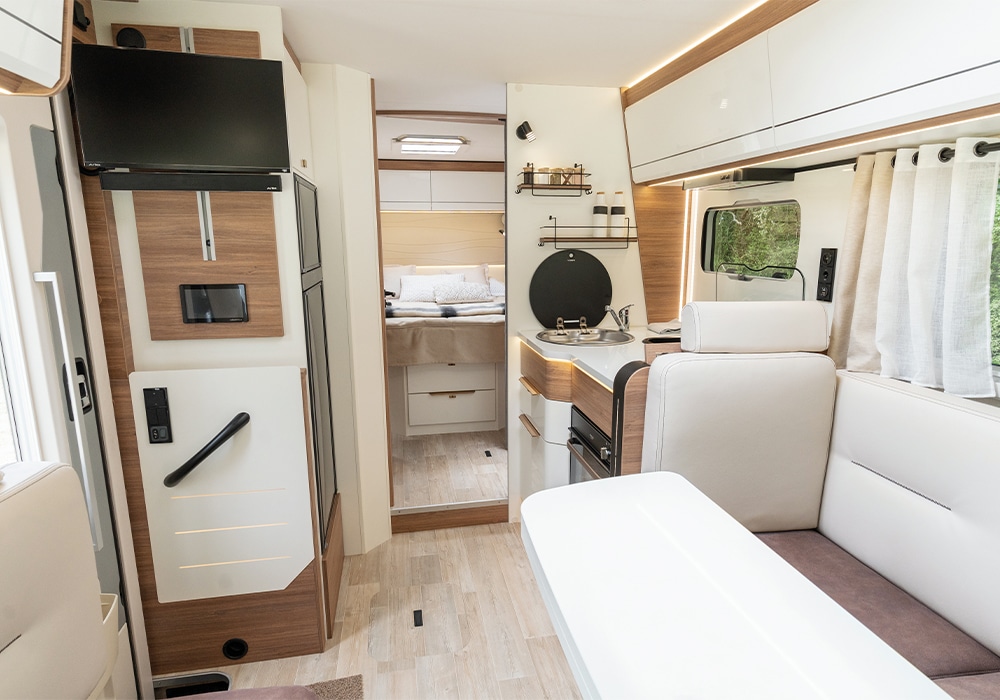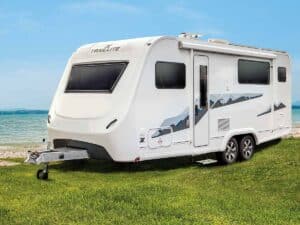Paul Owen has a fun time taking a good look around the spacious G740FC from Blenheim-based Deluxe RV Group.
Want an A-class motorhome that’s a bit gentler on the wallet than the swanky $285,000 Niesmann and Bischoff iSmove? Something that’s longer, and a bit less avant-garde with a lighter interior? Step this way to the $248,000 Pilote G740FC. It’s sensibly French, 7.49 metres long, and displays plenty of design flair.
The G740FC is almost identical in size and layout to the $215,000 Pilote P740 reviewed late last year, but there’s an obvious difference between the two. As a member of the Class A segment, the G-model is built on a naked Fiat Ducato van chassis, requiring Pilote to build all of the body structure on it. This is in contrast to the P-machine, which is built on a Ducato cab-chassis and retains all of Fiat’s original van sheetmetal up front with Pilote adding its own body behind that in typical Class C fashion.

Those with an engineering focus will instantly identify the G740 as a ‘fully-integrated’ motorhome and the P740 as a ‘semi-integrated’ example. So, what are the advantages and disadvantages of full-integration, and is it worth spending more on the G-badged Pilote instead of the P?
The $33,000 question
When the full- versus semi-integration debate is viewed through the prism of the Pilote range, the price difference between the two 740s could certainly buy something aspirational to tow, like a nice boat perhaps, or my pick: a pair of adventure motorcycles and a trailer. However, the spatial and design integrity advantages of the G740 over the P740 are immediately appreciated at first glance, so maybe the premium between the two 7.4m long Pilote models is worth paying. For you don’t bump your head when accessing and egressing the swivelling front seats of the G740 as the A-class body has vastly improved headspace up front and the standard drop-down double bed carried up there is more neatly stowed so it no longer intrudes into the cabin. The taller front glasshouse of the A-class model will always be appreciated, providing more panoramic views of the scenery when on the move, and letting more natural light into the cabin when parked up.

Parking and manoeuvring are also made easier for G740 drivers as the edges of the windscreen provide better reference points to how much clearance is available at the front of the vehicle. The driver also gets more seat-side storage, and there’s easier access to the two 9kg gas bottles on the outside, via a locker located below the driving position. The huge windscreen also comes with a bus-sized pair of wipers to wipe away the latest deluge. Pilote had to do more work to create the more spacious ambience inside the G740FC and its more attractive exterior looks. A new wiring loom needed to be tailored to service all the frontal systems of the van, along with new air-conditioning plumbing and vents. Several new GRP composite body panels needed to be designed and manufactured to fit snugly with the humongous windscreen. Add the cost of all this up and you get to a number that accounts for the price difference between the G740FC and P740FC.
But before you pump the extra $33K down on the G740FC, a few words of caution. The trump card that a semi integrated motorhome holds over its fully integrated alternative is safety. Swedish traffic authority, Trafikverket, is so far the only one in the world to perform crash tests on motorhomes. When it recently trashed two differently constructed models – semi-integrated and fully-integrated – by firing them into an offset barrier at 64kmh it found that the front end of the C-Class model absorbed more crash energy than that of the A-class version. The P740FC is also the preferred motorhome to be parked up in should a gas fire eventuate, due to it having three exit doors where the G740FC has two.

Fiat’s best Ducato
You get the bonus of a more powerful engine when opting for the G740 over the P740, as the 180bhp 2.2L turbodiesel of the A-class model develops 40 more brake horses than the 140bhp motivator of the Class-C model. Both motors come from the new engine family that powers the Ducato and its Citroën and Peugeot cousins. Although the Fiat Ducato, Peugeot Boxer, and Citroën Relay have long shared the same assembly line at the largest light commercial vehicle factory in the world, Fiat’s Sevel plant in Atessa, Italy, they’ve all featured their own brand specific powertrains until recently. With all three brands now under the umbrella of the fifth-largest automotive corporation in the world, Stellantis Group, the opportunity to standardise the powertrains of all three van ranges has been seized.
It’s the engine management software that determines the performance difference between the new van engines as they all share the same 2197cc four-cylinder architecture. Increased boost from the turbocharger is what creates the extra 40bhp that the G740FC lords over the P740 version, meaning that the ultra smooth refinement is shared by both engines. A major advantage of these new donks is that they’re lighter and more frugal with fuel. Fiat boasts that using all-new 2.2 has lowered the overall fuel consumption of the Ducato range by 10%.
This new-age diesel has the perfect mate in the form of ZF’s nine-speed automatic gearbox, and the calibration between these two major powertrain components is as sweet as it can be, the control modules as fully integrated with each other as Pilote’s aluminium-reinforced GRP body is with Fiat’s sturdy galvanised steel chassis in the G740FC.
Fiat’s eighth-generation Ducato also features new electronic architecture, allowing the fitting of more safety systems and upgrading the dash displays and driver controls. For the 2023 G740FC this means the fitting of a steering wheel with multiple buttons for secondary functions located the sweep of the driver’s thumb away, including the cruise control. Plus digital instruments that display more formats and screens so that you can source more information. Want to check the level in the AdBlue tank? A couple of pushes of a thumb on the appropriate part of the steering will quickly access that info.
A Pioneer head unit with an 11-inch touchscreen takes centre stage on the dashboard. It projects cellphone screens via Apple CarPlay and Android Auto, but also comes loaded with its own map of New Zealand so that navigation can continue when roaming away from mobile network coverage. It also displays a wide-angle view from the reversing camera which can also be accessed any time while driving forwards.
Groundhog day
As already mentioned, once you get past the cab area, the G740FC and P740FC could be identical twins. This means everything that impressed me about the semi-integrated version – it’s neatly-done double-floor installation with mid-level water tanks protected from frost; its quick conversion of the facing lounge seats into forward-fronting travel seats; and most of all, the tasteful use of wood veneers, eyecandy taps, and light-hued upholstery to enhance the interior décor – all carries over to the A-class Pilote. Entering it might feel like Groundhog Day to a reviewer who as already been previously very impressed by the P740FC, but it’s still a feel-good experience.
Entry is via a Thule powered slide out step and a standard-size motorhome side door. Tellingly, the larger 7.8m-long $285,000 G781devotes some of its extra 400mm of length to the fitment of a wider door more in keeping with the A-class norm. The extra space of the larger Pilote A-class model is all added to the front living area which confirms that the roomy nature of the kitchen, bathroom, and island bedroom of the G740 is considered more than adequate for the model that’s the next step up in the range.
Looking closer at the precise fit of the cabinetry, the two lift-up floor locker panels, the careful attention to detail is impressive. This might be one of the best value A-class motorhomes on the market, but it still delivers a luxurious cabin. If the décor of this particular G740FC isn’t to your liking there’s the choice of three wood veneers, two benchtop and splashback colours, four seat covers with a selection of either imitation leather or fabric, and five sets of curtains available. The latter are a more elegant way to screen the double glazed windows than the pullup/pulldown blinds and insect screens also provided.

With the layout not only mimicking that of the P740FC but most other European motorhomes of this length, the only real distinguishing feature are the double gas hobs fitted to the kitchen instead of the three burners of the P740FC. That’s because these hobs can boil water faster and they take up a bit more room. Below them is the gas oven/grill combo and a stack of deep drawers mounted into the L-shaped bench. Adjacent to the relatively deep sink are two spice/condiment racks reminiscent of a French cottage kitchen.

With a well-screened shower cubicle on one side, and a toilet on the other, the G740FC has a versatile comfort/grooming area. There’s a sliding door to separate it from the main bedroom and a swivelling door that either encloses the toilet/ washroom area or turns it into a private ensuite of the bedroom. The 1.9m x 1.5m island double bed has two hanging wardrobes on either side, leaving plenty of bedside bench space for hot drinks and reading matter. If laying in bed and watching TV is your thing, a wall-hung TV upgrade option is available for the bedroom, and there’s also an adjustable 22” TV mount up by the side door. Perfect for those rainy days or when you’re settling in to relax for the evening.


Camping free
A five-metre Thule awning comes standard with the G740FC, creating plenty of shade when parked up. Two 100Ah AGM habitation batteries are included as standard equipment and upgrades in solar energy harvesting, inverter DC/AC conversion, and extra battery storage are available from Blenheim-based Pilote importer, Deluxe RV Group. The G740FC can carry 130 litres of freshwater and collect and store up to 95 litres of greywater, while the toilet cassette can hold 18 litres. The tank capacities should enable a decent period of unsupported freedom camping. At such times the generously sized 2020 litre garage will be emptied of toys and equipment once all the tiedowns attached to the adjustable security points have been undone. Let the fun begin!
Pilote G740FC Floorplan
| SPECIFICATIONS | |
|---|---|
| MAKE & MODEL: | Pilote G740FC |
| CHASSIS: | Fiat Ducato chassis, front wheel drive |
| ENGINE: | 2.2 litre turbo-diesel, 180bhp |
| GEARBOX: | Nine-speed automatic |
| BERTHS: | 4 |
| LENGTH/WIDTH/HEIGHT: | 7490mm/2300mm/2850mm |
| FRESH/HOT/GREY WATER: | 135L/10L/95L |
| GVW/PAYLOAD: | 3650kg/690kg |
| UNLADED MASS (TARE): | 2960kg |
| PRICE: | From $248,000 |
For more information, visit https://www.deluxegroup.co.nz/












